Altcoins: What They Are and Why They Matter

Why Bitcoin Alone Isn’t Enough
The first cryptocurrency was created, but the industry didn’t stop there. Today, we have a vast ecosystem of digital assets, each offering a unique approach to blockchain technology. These assets are known as altcoins and form the foundation of Web3's technological diversity.
This article will explore altcoins, how they differ from Bitcoin, and why understanding them is crucial for founders and teams building crypto.
What Are Altcoins?
Altcoins refer to all cryptocurrencies launched after Bitcoin. Many were created to improve Bitcoin’s limitations or reimagine its technical framework. Some projects adopted elements of Bitcoin’s open-source code but modified them for different purposes, such as faster transaction speeds, smart contract functionality, or alternative consensus mechanisms.
The motivations behind altcoins vary: creating more scalable networks, lowering transaction fees, enabling new financial systems, or serving specific niches like DeFi, NFTs, GameFi, and identity management. A prime example is Ethereum, which introduced smart contracts and paved the way for decentralized applications.
Altcoins are not just secondary coins. They’ve become a driving force for innovation in the crypto space and the backbone of countless cutting-edge solutions.
How Many Cryptocurrencies Exist Today?
Estimates suggest between 5,000 and 10,000 cryptocurrencies exist as of 2024. Some are actively developing, while others have matured into global ecosystems with millions of users.
This growth shows that crypto isn’t just evolving vertically—it’s expanding horizontally. New projects emerge constantly, each targeting specific problems: from micro-payments to real-world asset tokenization. This variety isn’t chaos for founders—it reflects the many demands Web3 aims to solve through technology.
Native Coins vs. Tokens: What’s the Difference?
Native coins are the core assets of a blockchain. They’re issued directly by the network protocol, not through smart contracts. Examples include BTC on the Bitcoin network, ETH on Ethereum, and BNB on Binance Smart Chain. These coins pay gas fees, staking, governance, and other on-chain functions.
On the other hand, Tokens are built on top of existing blockchains. They don’t have independent ledgers but rely on platforms like Ethereum, Solana, or Avalanche. Most tokens are created through smart contracts and serve various roles—governing DAOs, unlocking product features, rewarding users, providing liquidity, and more.
For Web3 projects, understanding this distinction is critical. Launching a token isn’t just a way to raise capital—it’s an infrastructure decision that influences UX, game design, tokenomics, and community involvement.
Token Standards: ERC-20, ERC-721, and Beyond
The most widely used token standard is ERC-20. It laid the foundation for thousands of tokens that integrate seamlessly with wallets, exchanges, and DeFi protocols. Its uniform structure helped spark the rise of the token economy.
Other standards followed: ERC-721 for NFTs, ERC-1155 for hybrid assets (like in-game items), BEP-20 for the Binance Chain, and many more. Each serves specific purposes and supports unique use cases.
Understanding token standards empowers Web3 founders to make informed technical decisions and build scalable, future-ready products.
DeFi Tokens: The Financial Backbone of Web3
One of the most transformative applications of tokens is decentralized finance (DeFi). DeFi platforms allow users to borrow, swap assets, provide liquidity, and earn passive income without traditional banks. Tokens power all these functions.
Examples include AAVE, the governance and utility token of a lending protocol, and UNI, which gives users a voice in the future of Uniswap. These tokens enable users to do more than interact—they help shape the ecosystem.
DeFi tokens are more than just currency—they’re tools for incentives, governance, and ecosystem growth.
NFTs: Non-Fungible Tokens and Digital Ownership
Non-fungible tokens (NFTs) bring verifiable uniqueness to digital assets. They’re used in art, gaming, collectibles, and even for certifying rights to physical assets. The ERC-721 standard enabled actual ownership of digital content and unlocked a new layer of value in the blockchain space.
For founders, NFTs are a powerful way to create value and drive engagement. Whether a digital art collection or an in-game item, NFTs enable new business models based on scarcity, ownership, and community.
Stablecoins: Stability in a Volatile Market
Crypto’s volatility makes it difficult to use every day. Stablecoins solve this by pegging tokens to fiat currencies like the US dollar. The most popular are USDT, USDC, and DAI. These maintain a near-constant value of $1 and can be used for payments, savings, or trading without the price swings.
Stablecoins are a core component in many Web3 products, from DeFi protocols to NFT marketplaces and blockchain games. They offer users reliability, transparency, and ease of use.
Game Tokens and Play-to-Earn Economies
In Web3 games, tokens have become an integral part of gameplay. Players can not only spend resources but also earn them. Game tokens allow developers to build full-fledged economies with assets, marketplaces, and custom rules.
Examples include AXS and SLP in Axie Infinity, MANA in Decentraland, and SAND in The Sandbox. These ecosystems show that in-game currencies can have real-world value and applications beyond the game itself.
For Web3 game founders, game tokens offer a path to sustainable models through robust tokenomics, play-to-earn mechanics, and absolute asset ownership.
Final Thoughts
Altcoins are far more than Bitcoin alternatives. They represent a diverse and rapidly evolving ecosystem of coins and tokens, each solving unique problems and expanding blockchain capabilities. Understanding the distinctions between coins, tokens, standards, and their applications is foundational to building, launching, and scaling a successful Web3 product.
For crypto founders, this is a chance to choose the right stack, design a strong token economy, and deliver something more than “just another coin.”
If you’re building a Web3 product, planning a token launch, or looking to craft your go-to-market strategy, the Cware Labs team is here to support you, from idea to growth. Contact us to discuss your project.
Stay tuned to Cware Academy for more expert content — we publish in-depth guides tailored to Web3 founders, developers, and investors.
